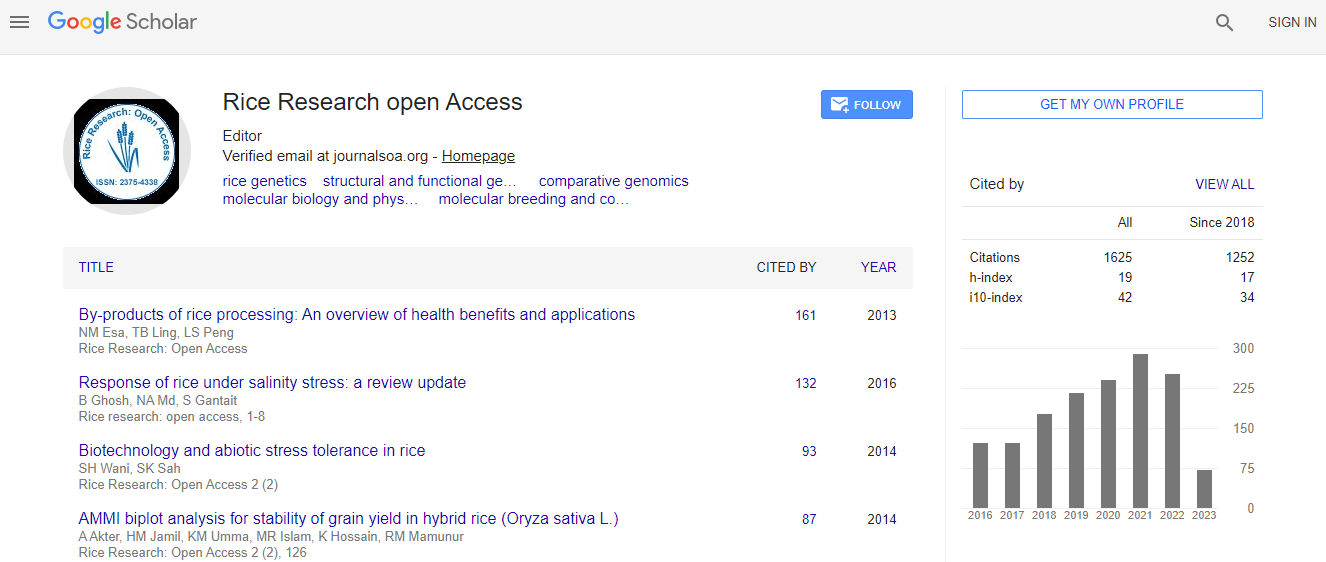Research Article
Influence of water depth and seedling rate on the performance of late season lowland rice (Oryza sativa L) in a Southern Guinea Savanna ecology of Nigeria
| Ismaila U1*, MGM Kolo2, Odofin JA2 and Gana AS2 | ||
| 1National Cereals Research Institute, Badeggi, P.M.B. 08, Bida, Nigeria | ||
| 2Federal University of Technology P.M.B. 65, Minna, Nigeria | ||
| Corresponding Author : | Ismaila U National Cereals Research Institute Badeggi, P.M.B. 08, Bida, Nigeria Tel: +2348059919975 E-mail: ismailaumar72@yahoo.com |
|
| Received January 31, 2014; Accepted February 24, 2014; Published February 26, 2014 | ||
| Citation: Ismaila U, Kolo MGM, Odofin JA, Gana AS (2014) Influence of water depth and seedling rate on the performance of late season lowland rice (Oryza sativa L) in a Southern Guinea Savanna ecology of Nigeria. J Rice Res 2: 122. doi: 10.4172/jrr.1000122 | ||
| Copyright: © 2014 Ismaila U, et al. This is an open-access article distributed under the terms of the Creative Commons Attribution License, which permits unrestricted use, distribution, and reproduction in any medium, provided the original author and source are credited. | ||
Related article at Pubmed Pubmed  Scholar Google Scholar Google |
||
Abstract
A three year field experiment was conducted between 2010 and 2012 at the irrigated lowland experimental field of National Cereals Research Institute in Edozhigi (9°04N, 6°7E) of the Southern Guinea savannah ecological zone of Nigeria, to determine the effect of different water depths and seedling rates on yield and yield components of lowland rice. The trial was laid out in a split plot and arranged in a randomized complete block design by six regimes of water depths (5 cm, 10 cm, 15 cm, 20 cm, saturated soil and continuous flow of water at 2 cm depth) was accommodated in the main plot while the seedling rate of 2, 4 and 6 per stand constituted the sub-plots. The results indicated that both grain yield and yield components of rice were enhanced while the water level increased to 20 cm, although both tiller and height were negatively affected by higher water level at the early stage of growth but it was later compensated at later stage. Water depth of 15 - 20 cm revealed higher grain yield of 5051.8, 4700.4 and 4066.0 kg ha-1 which was 84.4%, 85.2% and 84.7% higher than yields obtained from saturated plot in 2010, 2011 and 2012 respectively. Rice yield and yield components were significantly affected by different seedling rates and six seedlings per stand gave grain yield that is 13.1%, 27.8% and 14.4% higher than 2 seedling rate in 2010, 2011 and 2012, respectively. It is therefore concluded that maintaining water depth between 15 to 20 cm and seedling rate of 4 to 6 enhanced yield and yield components of lowland rice

 Spanish
Spanish  Chinese
Chinese  Russian
Russian  German
German  French
French  Japanese
Japanese  Portuguese
Portuguese  Hindi
Hindi 
